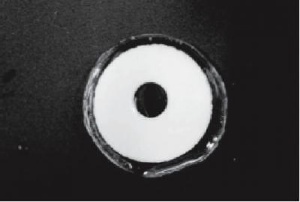Jul 21 2009
Taking eye drops multiple times a day can be difficult for patients to do, and because of blinking and tearing, as little as 1 to 7 percent of the dose is actually absorbed by the eye. Now, researchers led by Daniel Kohane, MD, PhD, director of the Laboratory for Biomaterials and Drug Delivery at Children's Hospital Boston, have developed special contact lenses that can gradually dispense a constant amount of medication to the eye, at adjustable rates. They describe their prototype lens in the July issue of Investigative Ophthalmology and Visual Science.
 This is a prototype drug-dispensing contact lens. Credit: Copyright 2009 Association for Research in Vision and Ophthalmology (ARVO).
This is a prototype drug-dispensing contact lens. Credit: Copyright 2009 Association for Research in Vision and Ophthalmology (ARVO).
Although other groups have developed drug-releasing contact lenses, none have been able to achieve a constant, steady release of substantial amounts of drug; typically, a burst of drug is delivered in the first few hours, followed by rapidly dwindling amounts that are too low to be therapeutic. Kohane, collaborator Joseph Ciolino, MD, of the Massachusetts Eye and Ear Infirmary, and colleagues at the Department of Chemical Engineering at the Massachusetts Institute of Technology (MIT) created a two-layer contact lens with an inner drug-bearing biodegradable polymer film known as PLGA. Both PLGA and pHEMA (used for the coating) have been well studied and are already approved for ocular use by the Food and Drug Administration.
In laboratory testing, the prototype lenses dispensed ciprofloxacin (an antibiotic often used in eyedrops) for 30 days, the longest duration for which contact lenses are currently approved by the FDA; in some tests, the lenses continued releasing drug for up to 100 days. The amounts dispensed were sufficient to kill pathogens in a laboratory assay.
Kohane and Ciolino see applications in conditions such as glaucoma and dry-eye which require frequent daily eye drops. They have begun to test the lens in animals and plan to begin human testing as soon as possible. The technology recently won the Life Sciences track in MIT's 100K Entrepreneurship Competition.